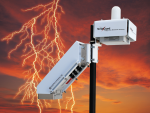This product is no longer available. Some accessories, replacement parts, or services may still be available.

| Services Available |
|---|
Overview
The CS110 kit includes:
- CS110 Electric Field Sensors
- 17642 CS110 Zero Electric Field Cover
- 18292 CR1000M Datalogger Installed Inside CS110
- CS110CBL1-L5m RS-232 cable for CS110 (5 metres)
- CS110CBL2-L5m CS I/O cable for CS110 (5 metres)
- CS110CBL3-L5m Power cable for CS110 (5 metres)
Images



Related Products
Technical Description
The CS110 uses a reciprocating shutter instead of the traditional rotating vane field mill. The reciprocating shutter is electrically connected to ground potential by a flexible stainless-steel strap. The strap operates below its fatigue limit, resulting in an ultra-reliable electrical ground connection to the shutter.
The reciprocating approach provides better low-frequency error performance than the traditional rotating vane field mill because it has a convenient zero-field (closed shutter) reference. The zero-field reference allows the CS110 to measure and then correct for electronic offset voltages, contact potentials, and leakage currents of each individual measurement (Patent Pending).
The CS110 also contains circuitry to measure and compensate for insulator leakage currents occurring on the charge amplifier input, eliminating measurement errors caused by fouled insulators. If insulator surfaces become conductive because of surface contamination, a leakage current compensation circuit applies an equal and opposite polarity current to the charge-amplifier input that prevents saturation of the electronics.
Warranty
The CS110 has a one year warranty against defects in materials and workmanship. Campbell Scientific does not warrant that the CS110 will meet customer’s requirements or that its operation will be uninterrupted or error-free.
Atmospheric or local electric field conditions or different site characteristics may cause false information, late data, or otherwise incomplete or inaccurate data. The CS110 only measures conditions that make lightning more likely. Just as with weather forecasts, the CS110 measurements only help assess the probability of lightning. Lightning can occur causing personal injury, even death, or damage to property without any warning from the CS110.
Campbell Scientific is not liable for special, indirect, incidental, or consequential damages from the use, failure, or malfunction of the CS110. A full statement of the CS110’s Warranty is contained in the CS110 Manual.
Compatibility
Datalogger Considerations
The CS110-LGR can be interfaced to another datalogger via the Power/SDM cable if the application requires an additional datalogger.
Programming
The CR1000’s on-board programming language, CRBasic, provides data processing and analysis routines that support user control over sample (measurement) rates and setting of alarm conditions. LoggerNet Datalogger Support Software facilitates programming, communications, and data retrieval between the CS110 and a PC.
Using the CS110 as a Weather Station
The CS110 has sealed connectors for attaching meteorological sensors and three digital control ports for controlling external devices and/or triggering alarms. The embedded CR1000 datalogger measures the sensors, processes the measurements, stores the data in tables, and can initiate communications.
Compatible Sensors
| Connector Label | Compatible Sensors (one sensor per connector) |
| Temp/RH | HMP60-L, HC2S3-L (choose the -C cable termination option for these sensors) |
| Wind | 05103-LC, 05106-LC |
| Solar | CS100 barometer, CS106 barometer (barometers connect to the CS110 via the 17460 cable; barometers must be housed in a separate enclosure such as the ENC100) |
| Rain | CS700-LC, TB4-LC, TE525-LC, TE525WS-LC, TE525MM-LC |
Compatible Communication Devices
Communication options compatible with the embedded CR1000 include direct connect, Ethernet, phone modems (land-line and cellular), radios, short haul modems, GOES satellite transmitters, and multidrop modems.
Zero Electric Field Cover
The 17642 Zero Electric Field Cover (ordered separately) is used to check the electric field offset voltage of the CS110. If the measured electric field is ≥|60 V/m| with the Zero Electric Field Cover on, then inspection and cleaning of the electrode surfaces is recommended.
SG000 Strike Guard Lightning Sensor
The SG000 (ordered separately) can be used in conjunction with our CS110 to create a complete lightning-threat measurement and analysis system. This system combines the advantages of two complementary lightning-warning technologies. The SG000 reports actual lightning strikes occurring at distances up to 20 miles—providing a comfortable warning time for incoming storms. The CS110 reports electric fields associated with local thunderstorm development—providing a warning prior to lightning strikes.
Specifications
- CE Compliance Standards to which conformity is declared: BS EN61326:2002
- Lightning Protection: Multi-stage transient protection on all external interfaces
- Power Requirement: 11 to 16 Vdc
- Baud Rates: Selectable from
300 to 115.2k bps - ASCII Protocol: one start bit, one stop bit, eight data bits, no parity
- Operating Temperature:
-25° to 50°C standard,
-40° to +85°C extended - Operating Relative Humidity: 0 to 100% RH
- Mounting: vertical pipe with outer diameter of
1.91 to 6.35 cm (0.75" to 2.5") - Dimensions:
15.2 x 15.2 x 43.2 cm
(6” x 6” x 17”) - Weight: 4 kg (9 lb)
Current Drain
- Peak Current Demand (occurs during motor operation): 750 mA
- Average at 1 sample per 10 seconds: 7 mA
- Average at 1 sample per second: 60 mA
- Average at 2 samples per second: 120 mA
- Average at 5 samples per second: 300 mA
Communication Ports
- 1 RS-232 port
- 1 CS I/O port used to interface with our peripherals such as a COM320 Voice Modem
- Digital Control Ports 1, 2, and 3 for alarm, asynchronous communications, or SDI-12 communications
Accuracya
- Parallel-Plate Configuration:
±1% of reading + 60 V m-1 offset - 2 m CM110 Tripod Configuration:
±5% of reading + 8 V m-1 offset
a - Refer to manual for resolution, sensitivity, and noise specifications.
